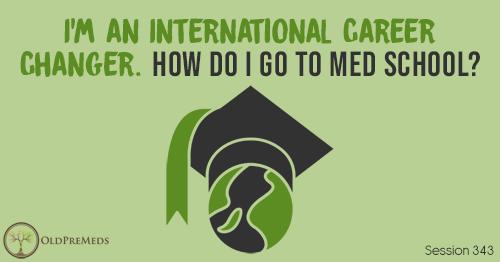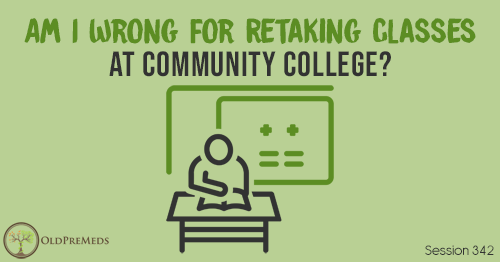Apple Podcasts | Google Podcasts
Session 343
This week, we get asked by an international student hoping to pursue medical school in the US. As a nontrad, international career-changer, what are this student’s chances of getting into medical school?
Questions answered here on the podcast are taken directly from premedhangout.com. Go ask your questions there and use #OPMquestion.
Also, please be sure to check out all our other podcasts on Meded Media as we try to bring you as many resources as you need on this journey.
Listen to this podcast episode with the player above, or keep reading for the highlights and takeaway points.
The MCAT Minute
The MCAT Minute is brought to you by Blueprint MCAT. Sign up for Blueprint MCAT’s free account to access their study planner tool. The study planner can generate a customized study plan based on a student’s availability and schedule conflicts to help them efficiently prepare for the MCAT.
OldPreMeds Question of the Week
“I’m an international student pursuing an engineering undergrad degree from India. I want to switch my career and go into medicine, I wish to pursue medical school in the US, but I do not know how to or where to start. After doing a lot of research, I found out that I can get into medical school. I have to do a postbac program and meet all of my prereqs.
The problem is that Postbac programs are not a thing in my country, nor is shadowing or any of the stuff required to get into medical school. I checked some Postbac programs in the US but all I could find was that I should be a US citizen to be eligible for these programs. I was hoping I could get some guidance from your side.”
Guidance for an International Student Pursuing Medicine in the US
For nontraditional students who are career changers, I say it’s a similar situation to wanting to change careers into medicine but not having any experience or prerequisites. The first step is needing to complete the prerequisites. Most medical schools still have formal prerequisite requirements like one year each of general chemistry, biology, organic chemistry, and a semester of biochemistry. It also requires a year of physics, and sometimes other courses like English, anatomy and physiology, psychology/sociology.
Using Mappd.com to Research Prereqs
Students need to do some homework to research prerequisite requirements. Check out Mappd.com, which has the most up-to-date prerequisite requirements for different medical schools. Students can then review the lists of prerequisites and see which courses they are missing to determine which schools they may be eligible to apply to.
The 90-Hour Rule for International Students and Those Who Studied Abroad
Many medical schools in the US have a requirement known as the “90 hour rule” for international students and those who completed their undergraduate studies abroad, even if they are US citizens. This rule requires that students complete at least 90 semester credit hours of coursework at a US institution.
“For international students and students who went overseas for their undergrad, even if you’re a US citizen, a lot of schools want 90 hours of US credits.”
The Purpose of the 90-Hour Rule
There are a few potential reasons why schools have implemented this 90-hour rule. It allows schools to evaluate if students can thrive in the American academic system. For non-native English speakers, it demonstrates their ability to learn and function in an English-speaking educational environment. Completing 90 credits at a US school also gives students exposure to American culture and ways of learning.
For international students who did their undergraduate degree abroad, most schools will not do a direct transcript evaluation and conversion of those credits to the US system. Some osteopathic schools may be more open to reviewing international transcripts. However, the majority of students in this situation end up completing an entire additional undergraduate degree at a US institution to satisfy the 90 credit requirement.
Taking Credits at a Community College
Community colleges are acceptable options for accumulating these 90 credits. Students can take prerequisite science courses and gain exposure to the US education system at a more affordable price point than a four-year university. Once the 90 hours are fulfilled, they can then focus their efforts on medical school prerequisites and applying to programs.
The 90-hour rule presents an additional hurdle for international students and those who studied abroad. Careful planning is needed to factor this requirement into their path to medical school in the US. Utilizing community college resources can help optimize time and finances spent fulfilling this standard for non-resident applicants.
Consideration of International Undergraduate Transcripts by Some Medical Schools
Some medical schools may evaluate an international undergraduate degree from a school in India. A small number of schools may review the transcript from the Indian university and attempt to convert the credits and GPA to an equivalent American system through an evaluation service like WES or another organization. However, it’s typically the osteopathic schools that are more open to considering transcript evaluations from international undergraduate institutions.
Some Medical Schools May Accept 30 Credit Hours at a US Institution
There are some medical schools that will accept an applicant having completed 30 credit hours at a US institution and then consider them for admission. This could potentially allow international students or those who studied abroad to fulfill a smaller course load requirement at a US school before applying, as opposed to the 90-credit hour policy at many other institutions.
“When you’re looking at 90 credits, you’re basically doing a whole another degree.”
Determining Medical School Options as an International Student
For international students pursuing medical school in the United States, the application process involves many layers of complexity. Therefore, you have to thoroughly research to determine which programs may even be possibilities. Not all medical schools accept international applicants, so this is an important initial factor to investigate.
The first step is for students to reflect on what general location, mission, or specialty focus they may be interested in. This can help provide an initial list of potential target schools. However, further vetting is required.
Researching Specific Policies and Prereqs Guidelines
Each school’s specific policies on international enrollment, credit requirements, and prerequisite expectations must be reviewed. Some accept direct transcript evaluations from foreign universities, while others mandate 90+ credits from a U.S. institution. Credit completion options like community college coursework should also be explored.
Prerequisite guidelines vary between institutions as well. Mapping out which classes are missing allows students to customize a plan. Resources like Mappd.com facilitate comparing prerequisites across programs.
Completing Activities and Clinical Experience Requirements as an International Student
Since opportunities for clinical experience, shadowing, and extracurricular activities related to medicine are limited for students studying in other countries, international applicants will need to spend time in the United States. They must come to the US at some point to take prerequisite courses, but also to gain experiences like shadowing physicians. They have to get themselves involved in health-related extracurriculars, which are necessary to include in medical school applications.
The Challenges of Pursuing Medical School in the US as an International Student
There are many factors at play for an international student pursuing medical school in the United States. And there are three major things are riding on their ability to succeed in this process.
Firstly, they will need to obtain the proper student visa that allows them to travel and study in the US. Gaining visa approval can be an obstacle in and of itself.
Secondly, studying as a non-resident comes with significant financial costs such as tuition, living expenses, application fees, and healthcare. Only those with the financial privilege will be able to support themselves for the extended time required in the US.
Thirdly, despite their best efforts in completing prerequisites, activities, and applying through AMCAS or AACOMAS, there is no guarantee of admission. International students must hope that their performance and applications are compelling enough for acceptance at a US medical program. All of the work put in to fulfill requirements relies on the end goal of admission, which remains out of the student’s control.
These visa, financial, and uncertainty factors add substantial pressure and risk to an international student’s journey to American medical school. Hence, careful planning is vital to navigate this process.












